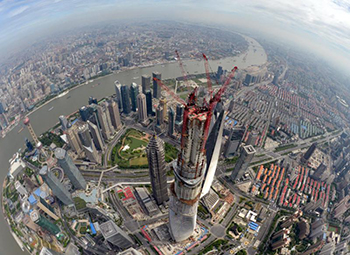China’s Tallest Building Faces Completion
 SHANGHAI, China — After four years of construction, Thornton Tomasetti, with offices in Shanghai, announced earlier this month the topping out of the 2,073-foot-tall Shanghai Tower, China’s tallest building and the world’s second tallest after the 2,722-foot-tall Burj Khalifa building in Dubai, United Arab Emirates.
SHANGHAI, China — After four years of construction, Thornton Tomasetti, with offices in Shanghai, announced earlier this month the topping out of the 2,073-foot-tall Shanghai Tower, China’s tallest building and the world’s second tallest after the 2,722-foot-tall Burj Khalifa building in Dubai, United Arab Emirates.
Thornton Tomasetti provided structural engineering and curtain wall peer review services for the project, creating a structural system that gives the building a distinctive twisting, tapering shape, while rotating 120 degrees as it rises. The exterior of the tower encircles an inner concrete structure, comprised of nine cylinders stacked on top of each other. The columns that support the twisting-form curtain wall provide an effective system for tall buildings to resist wind and seismic loads.
The design of the tower incorporates several green building elements. The outer skin, for instance, features laminated glass panels that filter the sun, wind and rain. Its inner skin encloses the interior space with a conventional unitized low-E coated insulating glass curtain wall with operable solar control devices. The double curtain wall provides natural ventilation and cooling, and collects and recycles rain water.
The building is situated adjacent to China’s current tallest building, the 1,614-square-foot Shanghai World Financial Center. Gensler served as the architect on the 121-story, glass-and-steel structure, and Shanghai Tower Construction & Development Co. served as the developer. Both have offices in Shanghai.
By the time the Shanghai Tower is completed in 2014, it may be surpassed as China’s tallest structure by Sky City, a 2,749-foot-tall building being built in Changsha, Hunan, China. Broad Sustainable Building broke ground on the next tallest building in the world in July.
The $1.5 billion structure continues to make headlines because of its speedy construction process — slated for completion in 2014 — matched by significant sustainability initiatives. For instance, the building is designed to achieve five times more energy efficiency than conventional buildings with more than 20 energy-saving technologies, such as 20-centimeter thermal insulation external walls, four-paned windows, LED lighting, auto power-generated lifts and fresh air heat recovery. Air quality is set to consist of 100 percent fresh air without cross contamination, fresh air with three-stage filters and eliminating PM2.5 in the air by 99 percent.
